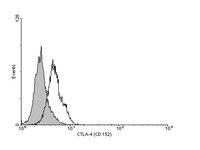04-963 Sigma-AldrichAnti-CTLA4 (CD152) Antibody, clone 9H10
Anti-CTLA4 (CD152) Antibody, clone 9H10 is an antibody against CTLA4 (CD152) for use in WB, FC & IP.
More>> Anti-CTLA4 (CD152) Antibody, clone 9H10 is an antibody against CTLA4 (CD152) for use in WB, FC & IP. Less<<Produits recommandés
Aperçu
| Replacement Information |
|---|
Tableau de caractéristiques principal
| Species Reactivity | Key Applications | Host | Format | Antibody Type |
|---|---|---|---|---|
| M | WB, FC, IP | Ht | Purified | Monoclonal Antibody |
| References |
|---|
| Product Information | |
|---|---|
| Format | Purified |
| Control |
|
| Presentation | Purified hamster monoclonal IgG in buffer containing 0.1 M Tris-Glycine (pH 7.4) with 150 mM NaCl and 0.05% sodium azide. |
| Quality Level | MQ100 |
| Physicochemical Information |
|---|
| Dimensions |
|---|
| Materials Information |
|---|
| Toxicological Information |
|---|
| Safety Information according to GHS |
|---|
| Safety Information |
|---|
| Storage and Shipping Information | |
|---|---|
| Storage Conditions | Stable at 2-8°C for 1 year from date of receipt. |
| Packaging Information | |
|---|---|
| Material Size | 100 µg |
| Transport Information |
|---|
| Supplemental Information |
|---|
| Specifications |
|---|
| Global Trade Item Number | |
|---|---|
| Référence | GTIN |
| 04-963 | 04053252671722 |
Documentation
Anti-CTLA4 (CD152) Antibody, clone 9H10 FDS
| Titre |
|---|
Anti-CTLA4 (CD152) Antibody, clone 9H10 Certificats d'analyse
| Titre | Numéro de lot |
|---|---|
| Anti-CTLA4 (CD152), clone 9H10 - 2395685 | 2395685 |
| Anti-CTLA4 (CD152), clone 9H10 - 2299145 | 2299145 |
| Anti-CTLA4 (CD152), clone 9H10 - 2316807 | 2316807 |
| Anti-CTLA4 (CD152), clone 9H10 - 3251016 | 3251016 |
| Anti-CTLA4 (CD152), clone 9H10 - 3762559 | 3762559 |
| Anti-CTLA4 (CD152), clone 9H10 - NRG1704146 | NRG1704146 |
| Anti-CTLA4 (CD152), clone 9H10 -2522087 | 2522087 |
| Anti-CTLA4 (CD152), clone 9H10 -2608446 | 2608446 |
| Anti-CTLA4 (CD152), clone 9H10 -2654209 | 2654209 |
| Anti-CTLA4 (CD152), clone 9H10 -2791198 | 2791198 |
Brochure
| Titre |
|---|
| Advancing cancer research: From hallmarks & biomarkers to tumor microenvironment progression |


















